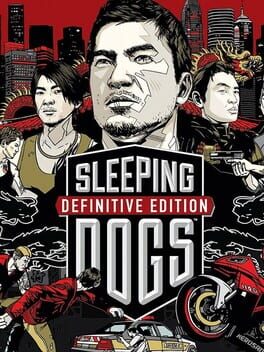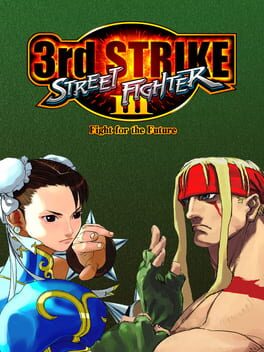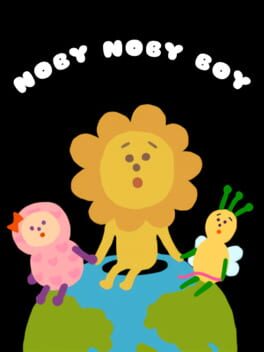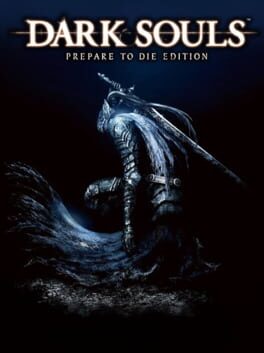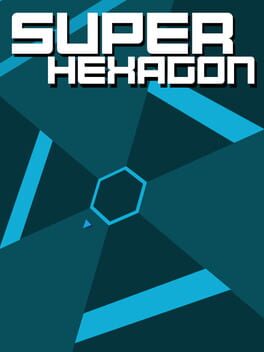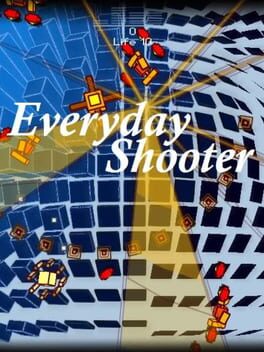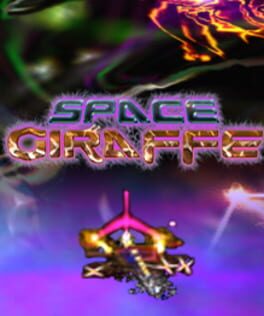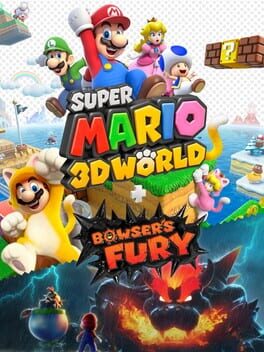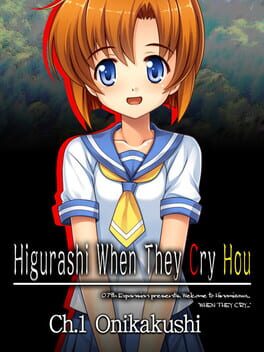Teog
77 Reviews liked by Teog
Dark Souls III
2016
drunk thoughts:
- our spectacle is entirely metatextual
-The game is a fail at the beginning. the drama adopts the triads as an aesthetic element rather than as a real device for conflict. Any protocol or issue related to the triads is taken more from the collective imagination, more from and closer to the mafias of Europe than to those of Asia.
Of course, in the end, the bad guy was the Occidental.
-Less vulgar (vulgar images and spaces are good) than it appears and more organized (poorly) than it should. Any moment is approached from the same common ground as all modern action games with open-world structures: (efficient) fights and (horrible) shootouts here, chases there, on foot or in vehicles. Follow the line on the minimap, don't get lost.
and bro, nothing really matters when no set-piece takes advantage of the architecture. Why Hong Kong? I play because I'm supposed to be Hong Kong, but until I raise the camera slightly I can't tell these digital streets apart from others I've already seen. The camera does not emphasize anything or let me take a look on my own, it is hermetic and protocol business.
And how can it be? There is pampering here. Yes there is architectural mime (I guess)
-the True -True Crime Hong Kong: the city is a zombie set where the little life of space begins and ends with its references to the cinema. God, what a pain to see PTU reduced to a couple of fights and encryption minigames
Anyone who has seen Johnnie To knows that the monster, the titan and the biggest character in HK cinema is the city itself.
but here is just a wallpaper.
- our spectacle is entirely metatextual
-The game is a fail at the beginning. the drama adopts the triads as an aesthetic element rather than as a real device for conflict. Any protocol or issue related to the triads is taken more from the collective imagination, more from and closer to the mafias of Europe than to those of Asia.
Of course, in the end, the bad guy was the Occidental.
-Less vulgar (vulgar images and spaces are good) than it appears and more organized (poorly) than it should. Any moment is approached from the same common ground as all modern action games with open-world structures: (efficient) fights and (horrible) shootouts here, chases there, on foot or in vehicles. Follow the line on the minimap, don't get lost.
and bro, nothing really matters when no set-piece takes advantage of the architecture. Why Hong Kong? I play because I'm supposed to be Hong Kong, but until I raise the camera slightly I can't tell these digital streets apart from others I've already seen. The camera does not emphasize anything or let me take a look on my own, it is hermetic and protocol business.
And how can it be? There is pampering here. Yes there is architectural mime (I guess)
-the True -True Crime Hong Kong: the city is a zombie set where the little life of space begins and ends with its references to the cinema. God, what a pain to see PTU reduced to a couple of fights and encryption minigames
Anyone who has seen Johnnie To knows that the monster, the titan and the biggest character in HK cinema is the city itself.
but here is just a wallpaper.
Disco Elysium is undeniably one of the most concentrated, and achieved, works to focus on individual introspection on the most granular level. It’s clear about it from the get go, it begins with a typical RPG character builder, then an inner dialogue, with the background of a pitch black screen, then the first steps in the game in a cramped hotel room, where the inner voices will be your first companions, and finally the first long dialogue tree being established with, of course, a mirror. There is an important detail revealed in this first contact, the main character doesn’t remember anything, not even his own name. If there is not a memory, not a past, only one thing remains, the current self. The absence and rediscovery of identity flow in a perpetual conversation from our protagonist to the whole of Martinaise and back.
Though its RPG abstractions may seem childish at first (and they are, as in imaginative), the game creates a system to represent the particular human being through their various voices/traits. It zooms into what seemed to be already atomic and divides again. It may look like a total misunderstanding of something that is impossible to classify, let alone gamify, though, the brilliance is in being unashamed of its decision, of using the system as a means to construct the being, and not as a goal.
The presence of a layer of humor helps to ease its mechanical premise, and it won’t take long to be delighted with the flavor that each voice has. This same humor helps to introduce its devastated world. Disco Elysium’s premise is an easy subject to throw in the misery well, yet the total opposite occurs. The at first chaotic mind of our detective turns out to be the perfect lenses through which to discover an hypersensorial world where each corner and conversation is a suggestive sign of life, past or present, still palpable regardless. As our job is that of a detective, our instinct will be of adventuring, exploring and, of course, talking. The conversations are soon revealed as labyrinths where each character traces a glimpse of their own world. A world so present and so alive in so many people that their existence and their connection end up weaving the tapestry that is the true human life of seemingly dead Martinaise.
The game is insistent on searching for life in the home of death. A commercial mall where no store survives becomes the place for a woman to give birth to roleplaying dice, even if the roleplayers and game makers are gone too. An abandoned church becomes the home of the night raves of the youth that wants to connect with the ethereal in their own terms. The human vitalism is evident, the melancholy of Disco Elysium is noticing that the unstoppable external interests to exploit Martinaise inevitably permeate every one of these lives.
After life -- death;
After death -- life again.
Though its RPG abstractions may seem childish at first (and they are, as in imaginative), the game creates a system to represent the particular human being through their various voices/traits. It zooms into what seemed to be already atomic and divides again. It may look like a total misunderstanding of something that is impossible to classify, let alone gamify, though, the brilliance is in being unashamed of its decision, of using the system as a means to construct the being, and not as a goal.
The presence of a layer of humor helps to ease its mechanical premise, and it won’t take long to be delighted with the flavor that each voice has. This same humor helps to introduce its devastated world. Disco Elysium’s premise is an easy subject to throw in the misery well, yet the total opposite occurs. The at first chaotic mind of our detective turns out to be the perfect lenses through which to discover an hypersensorial world where each corner and conversation is a suggestive sign of life, past or present, still palpable regardless. As our job is that of a detective, our instinct will be of adventuring, exploring and, of course, talking. The conversations are soon revealed as labyrinths where each character traces a glimpse of their own world. A world so present and so alive in so many people that their existence and their connection end up weaving the tapestry that is the true human life of seemingly dead Martinaise.
The game is insistent on searching for life in the home of death. A commercial mall where no store survives becomes the place for a woman to give birth to roleplaying dice, even if the roleplayers and game makers are gone too. An abandoned church becomes the home of the night raves of the youth that wants to connect with the ethereal in their own terms. The human vitalism is evident, the melancholy of Disco Elysium is noticing that the unstoppable external interests to exploit Martinaise inevitably permeate every one of these lives.
After life -- death;
After death -- life again.
"You know, there are many different approaches you can take to game design. One approach, which we took in SF3, is to design your game around "unanswerables." I think with any game, players will search for the best tactic, the best strategy... like, if X happens, you should always do Y; if you do this here, you'll always win. There's competitive games like that, where the match is essentially a confrontation of theoretical knowledge that each player has built up. But Street Fighter 3 is a game that, by design, doesn't have a fixed answer to those questions. There is no "best" tactic; you can spend your whole life trying to find the perfect theoretical approach to a situation in SF3, but it will never be quite right. You always have to be reading your opponent in the moment; you can't just fall back on your theories. It's a game that lets you search for answers... Forever."
- Shinichiro Obata, Street Fighter III planner, Capcom Japan
- Shinichiro Obata, Street Fighter III planner, Capcom Japan
Noby Noby Boy
2009
Cuando me regalaron una vieja PS3 pirateada venia ya este juego instalado, la verdad que al principio lo prejuzgaba mucho por parecerme muy infantil con esos diseños de Discovery Kids y decidí pasar de largo sin haberlo probado.
No fue hasta que me dejaron a cargo de cuidar a mi sobrina y la dejé con Noby Noby Boy.
A cada rato ella me llamaba por cualquier cosa que podia hacer en el juego, una frase más increíble que la interior... hasta que lo vi en pantalla, ver para creer como dicen.
No sé bien como describir a Noby Noby Boy, te dan un espacio lleno de juguetes pero solo te dejan agarrar uno solo, ese uno acaba siendo el mejor juguete que cualquier nene o nena puede tener en su vida.
Las cinco estrellas que le tengo a este juego no es por haberlo jugado, es por ver a ella disfrutar como nunca con Noby Noby Boy y realizar cosas que creía imposible en un juego. Me guardo cada historia y momento en mi cabeza como álbum familiar.
El bichito que se estira y se encoge no tendría tanta vida sin las manos de inocencia.
Ojalá más juegos como este y ojalá volver a ser niña.
No fue hasta que me dejaron a cargo de cuidar a mi sobrina y la dejé con Noby Noby Boy.
A cada rato ella me llamaba por cualquier cosa que podia hacer en el juego, una frase más increíble que la interior... hasta que lo vi en pantalla, ver para creer como dicen.
No sé bien como describir a Noby Noby Boy, te dan un espacio lleno de juguetes pero solo te dejan agarrar uno solo, ese uno acaba siendo el mejor juguete que cualquier nene o nena puede tener en su vida.
Las cinco estrellas que le tengo a este juego no es por haberlo jugado, es por ver a ella disfrutar como nunca con Noby Noby Boy y realizar cosas que creía imposible en un juego. Me guardo cada historia y momento en mi cabeza como álbum familiar.
El bichito que se estira y se encoge no tendría tanta vida sin las manos de inocencia.
Ojalá más juegos como este y ojalá volver a ser niña.
Tu pequeñez al cruzar ciudades divinas, arrasadas por el tiempo. Usar las almas de los enemigos como moneda de cambio, la humanidad como forma de mantener la cordura, sentarte abatido para descansar en la hoguera. La magia omnipresente, no en las luces de los hechizos que lanzamos, sino en los lugares que visitamos: dragones en puentes, estatuas de piedra que cobran vida en jardines secretos, muros ilusorios que desvelan mundos ocultos. Un juego de descender: a los abismos más oscuros de la humanidad, a la peor decadencia de los dioses, a los infiernos que creamos y llevamos dentro. La empatía por los compañeros de viaje que nos cruzamos por el camino; cada uno con sus propios problemas y motivaciones; todos con algún detalle característico que los vuelve únicos e inolvidables. No solo observamos sus historias, los acompañamos, les ayudamos y nos ayudan, mediamos y determinamos sus caminos. Pero al final, solo un resultado. Y cómo duele ese resultado. Da igual las veces que me haya pasado el juego, la desolación absoluta de la guardiana del Santuario de Fuego me seguirá conmoviendo. Su pequeña ilusión de que todo se arregle, que la maldición termine y su dolor cese avivando la llama original me seguirá rompiendo algo por dentro.
-Texto originalmente escrito en noviembre de 2019
¿De qué va Dark Souls?
- Repaso de la desmitificación, el tema principal del juego. Junio de 2019
Izalith Perdida
-Análisis de la zona más infame y una de mis favoritas. Mayo de 2021
Recopilación de fanarts
Hoguera consumida
-Crítica a la prensa de videojuegos y a la decadencia de la saga. Febrero 2022.
Quería dejar recopilado todo esto aquí porque seguramente no vuelva a escribir más sobre Dark Souls. Me dejo en el tintero fragmentos de un texto que nunca tomó forma sobre la humanidad y el abismo (al estilo del de Izalith) y que ya no merece la pena rescatar. Es el juego que más me ha marcado y cada vez que he vuelto a él he sacado cosas nuevas. Me ha tenido años obsesionado reccurrentemente, durante largos periodos, desde la primera vez que lo jugué. Es mi juego favorito y lo que encuentro en él no lo he visto en ningún otro. Simplemente ya toca pasar página. Tras haber jugado Demon's, DS3, Bloodborne, Sekiro y haber mirado atrás y descubierto los orígenes de fromsoft en King's Field y Shadow Tower, con una visión general más clara, ya solo me queda jugar Dark Souls 2 este verano y cerrar definitivamente el círculo.
-Texto originalmente escrito en noviembre de 2019
¿De qué va Dark Souls?
- Repaso de la desmitificación, el tema principal del juego. Junio de 2019
Izalith Perdida
-Análisis de la zona más infame y una de mis favoritas. Mayo de 2021
Recopilación de fanarts
Hoguera consumida
-Crítica a la prensa de videojuegos y a la decadencia de la saga. Febrero 2022.
Quería dejar recopilado todo esto aquí porque seguramente no vuelva a escribir más sobre Dark Souls. Me dejo en el tintero fragmentos de un texto que nunca tomó forma sobre la humanidad y el abismo (al estilo del de Izalith) y que ya no merece la pena rescatar. Es el juego que más me ha marcado y cada vez que he vuelto a él he sacado cosas nuevas. Me ha tenido años obsesionado reccurrentemente, durante largos periodos, desde la primera vez que lo jugué. Es mi juego favorito y lo que encuentro en él no lo he visto en ningún otro. Simplemente ya toca pasar página. Tras haber jugado Demon's, DS3, Bloodborne, Sekiro y haber mirado atrás y descubierto los orígenes de fromsoft en King's Field y Shadow Tower, con una visión general más clara, ya solo me queda jugar Dark Souls 2 este verano y cerrar definitivamente el círculo.
Mother
1989
Mitología estadounidense a través de infinitas referencias a la cultura pop aplicada a un juego de género, que explota la libertad de su base para presentar una aventura de inocencia e ingenuidad. La música como el elemento mágico, capaz de salvar a la humanidad de su propia oscuridad. ¿Qué haces cuando el fin del mundo llama a la puerta? Bailas. ¿Cómo vences al malo y salvas el mundo? Cantando.
Versión larga: https://yosoyira.medium.com/mother-a1ebd1625ba3
Versión larga: https://yosoyira.medium.com/mother-a1ebd1625ba3
Super Hexagon
2012
While I can't help but admire Terry Cavanagh's commitment to his concept, Super Hexagon is more compelling to watch than to play. The visuals have a unique hypnotic beauty, and you can even close your eyes and get lost in Chipzel's urgent, ever-evolving soundtrack. But as an arcade-style challenge, Super Hexagon doesn't keep me coming back for more. Its simplicity is its greatest strength and weakness. The paradox follows: Super Hexagon would be less remarkable if it were more complex, yet I find myself wanting more of a reason to stay engaged as a player outside of getting used to the game's patterns to arrive at a sense of accomplishment. Being a mere spectator allows me to focus on Cavanagh's artistic conviction as well as relish the interplay between Chipzel's music, the pulsing shapes, and the constant string of narrowly avoided collisions; playing Super Hexagon leads me to question its long-term experiential appeal.
Proteus
2013
Maybe it's just my personal associations with the pixelated view of a world full of nature and my memories of the indie scene at the time, but the first impression of Proteus is reminiscent of Minecraft. Where the world importance comes from its elements and not their particular arrangement, capable of being procedurally generated, making each particular world unique and common at the same time. The major difference, all your world changing actions are taken away. What is left is one of the most important aspects in any game, and in life, to observe. Navigating through a hypersensitive world, since observation and perception are the sole focus, everything seems to carry some life.
Observing how the world changes and how perception changes the world. Getting atop a mountain when the rain comes to see the sky again, to know what time it is, look down again to see that the land has turned into the sea, descend into it and watch how the sky is now the sea. To find comfort upon finding that this world has a moon when the night comes too. Try to find a pattern in the stars, look at the land and see that the lights are mirrored below. Discover that, same as everywhere, magic appears at night.
One of the most important moments is to stand still and observe what's out of reach. How the clouds move, how the sun goes down and how the moon rises on the opposite side. Everything is the life of nature, except for the human tombstones. Because it's about opposites too. To appear on the sea facing the land where to spend the rest of your time. To do anything but escape the cycle of day and night and then seasons and then life.
If Proteus is about life, and life is about observing, the game, of course, can only end in one way. An eye getting closed.
Observing how the world changes and how perception changes the world. Getting atop a mountain when the rain comes to see the sky again, to know what time it is, look down again to see that the land has turned into the sea, descend into it and watch how the sky is now the sea. To find comfort upon finding that this world has a moon when the night comes too. Try to find a pattern in the stars, look at the land and see that the lights are mirrored below. Discover that, same as everywhere, magic appears at night.
One of the most important moments is to stand still and observe what's out of reach. How the clouds move, how the sun goes down and how the moon rises on the opposite side. Everything is the life of nature, except for the human tombstones. Because it's about opposites too. To appear on the sea facing the land where to spend the rest of your time. To do anything but escape the cycle of day and night and then seasons and then life.
If Proteus is about life, and life is about observing, the game, of course, can only end in one way. An eye getting closed.
Super Mario Bros.
1985
I made a video about this game for the 35th anniversary (it's on Spanish, but you can see English subtitles): https://youtu.be/8rqiakCOatU
---------------------------------------------------------------------------------
The importance of the original Super Mario Bros. can't be understated: It doesn't have to do with being a genre pioneer, since games like Jump Bug, Pitfall or Pac-Land already included the jump mechanic, and the Mario franchise already had two games behind its back: Donkey Kong and Mario Bros. It isn't about being the sidescrolling game either, since Pac-Land's and Jump Bug's also scrolled their screens alongside the player, and a few days after the original Super Mario we had Makaimura on the arcades, which also included the jump mechanic alongside a screen that followed the player. What differentiates Super Mario Bros. from its predecessors is the creation of a world surrounding a mechanic, specifically the jump.
Shigeru Miyamoto's focus is the direct perception of the interactive premise for the player's immersion, and for that purpose there is particular care to the tangible effect of the environments. In simpler terms, that you can perceive the worlds physically. The key element is the depth in the aerial maneuverability. Super Mario Bros. allows a detailed control of the avatar while moving in the air. The weight of gravity in the impulse, the inertia in the jump direction in opposition to the player's command, and the feeling to confront the game's physical laws. To redirect the path of the avatar the stronger one presses the button. Such capability gives the aerial space to take relevance in the gameplay, since it's how the player decides their position, and thus the player becomes conscious of its position at any moment.
To give purpose to these controls, the game turns jumping in the main form of interacting with the environment. Obstacles can be avoided through jumping, similarly to Pac-Land, which was Super Mario Bros.'s main inspiration, but enemies can be defeated if we step on them, and that becomes a step forward by adding variables that react to our presence. The other form of including the jump in the gameplay is to hit blocks. Some of them contain coins that allow an additional chance to continue if you collect hundred of them, others contain upgrades to take a hit, being able to attack at distance, or time-limited invincibility. Some of them contain extra lives, others can be broken to make a path, or even allow access to other areas. The content of the blocks isn't immediately obvious since its appearance doesn't follow a pattern. They can be signaled, they can appear as another type of block and they can even be invisible. Basically, they're a secret, and this gives the game the sense of hiding more than what it appears to have, since it's optional content.
The intention of a world with a hidden face is manifested through pipes that lead to underground (or even underwater) passages, or vines that climb up to a world hidden in the sky. Even passages outside of the conventional interface of the game. That's why the decision of verticality as an abstraction of depth takes paramount importance to build places far from the surface, from what we know at first sight, and the focus on the vertical jump becomes thus a coherent decision since those are places that aren't reachable by just jumping, and they're hidden to our virtual body.
Because of how important it is to the progress of the player alongside its integration with the main mechanic of the game, the presence of a hidden world becomes an omnipresent feeling that differentiates Super Mario Bros. from other platformers that came after due to its influence, even among its own successors, because it means that the player perceives, decides its progress and leaves its presence in the world through jumping. Miyamoto turned thus this mechanic as a vehicle to expand the possibilities of exploration and personal body expression in a way that thirty-five years later still remains radical.
There's a last design decision that is very special and I haven't covered yet, and it is not being able to turn back. It isn't due to technical limitations since many of the previously mentioned games allowed it. Not being able to turn back is a deliberate decision because it makes the player potentially miss content that they won't be able to get if they didn't know about it, and that resonates to a surprisingly more profound level: The possibility to have missed something, to not have visited a place in a journey, to have taken something for granted at a certain point in time, because there's no coming back. By appealing to this sensation, the game's world takes presence in the player's mind even after having left an area behind, or even the whole game, because there's the lingering feeling of everything we didn't know and everything that could have helped us. That feeling is absent in the Mario games that came to the west after this one, which gives the original an unique quality. It's this sentiment that immortalizes Shigeru Miyamoto's masterpiece beyond what it meant back in the 80s in front of its predecessors, and it still represents the promise of videogames of worlds that can still capture our imaginations and warp our minds to them.
---------------------------------------------------------------------------------
The importance of the original Super Mario Bros. can't be understated: It doesn't have to do with being a genre pioneer, since games like Jump Bug, Pitfall or Pac-Land already included the jump mechanic, and the Mario franchise already had two games behind its back: Donkey Kong and Mario Bros. It isn't about being the sidescrolling game either, since Pac-Land's and Jump Bug's also scrolled their screens alongside the player, and a few days after the original Super Mario we had Makaimura on the arcades, which also included the jump mechanic alongside a screen that followed the player. What differentiates Super Mario Bros. from its predecessors is the creation of a world surrounding a mechanic, specifically the jump.
Shigeru Miyamoto's focus is the direct perception of the interactive premise for the player's immersion, and for that purpose there is particular care to the tangible effect of the environments. In simpler terms, that you can perceive the worlds physically. The key element is the depth in the aerial maneuverability. Super Mario Bros. allows a detailed control of the avatar while moving in the air. The weight of gravity in the impulse, the inertia in the jump direction in opposition to the player's command, and the feeling to confront the game's physical laws. To redirect the path of the avatar the stronger one presses the button. Such capability gives the aerial space to take relevance in the gameplay, since it's how the player decides their position, and thus the player becomes conscious of its position at any moment.
To give purpose to these controls, the game turns jumping in the main form of interacting with the environment. Obstacles can be avoided through jumping, similarly to Pac-Land, which was Super Mario Bros.'s main inspiration, but enemies can be defeated if we step on them, and that becomes a step forward by adding variables that react to our presence. The other form of including the jump in the gameplay is to hit blocks. Some of them contain coins that allow an additional chance to continue if you collect hundred of them, others contain upgrades to take a hit, being able to attack at distance, or time-limited invincibility. Some of them contain extra lives, others can be broken to make a path, or even allow access to other areas. The content of the blocks isn't immediately obvious since its appearance doesn't follow a pattern. They can be signaled, they can appear as another type of block and they can even be invisible. Basically, they're a secret, and this gives the game the sense of hiding more than what it appears to have, since it's optional content.
The intention of a world with a hidden face is manifested through pipes that lead to underground (or even underwater) passages, or vines that climb up to a world hidden in the sky. Even passages outside of the conventional interface of the game. That's why the decision of verticality as an abstraction of depth takes paramount importance to build places far from the surface, from what we know at first sight, and the focus on the vertical jump becomes thus a coherent decision since those are places that aren't reachable by just jumping, and they're hidden to our virtual body.
Because of how important it is to the progress of the player alongside its integration with the main mechanic of the game, the presence of a hidden world becomes an omnipresent feeling that differentiates Super Mario Bros. from other platformers that came after due to its influence, even among its own successors, because it means that the player perceives, decides its progress and leaves its presence in the world through jumping. Miyamoto turned thus this mechanic as a vehicle to expand the possibilities of exploration and personal body expression in a way that thirty-five years later still remains radical.
There's a last design decision that is very special and I haven't covered yet, and it is not being able to turn back. It isn't due to technical limitations since many of the previously mentioned games allowed it. Not being able to turn back is a deliberate decision because it makes the player potentially miss content that they won't be able to get if they didn't know about it, and that resonates to a surprisingly more profound level: The possibility to have missed something, to not have visited a place in a journey, to have taken something for granted at a certain point in time, because there's no coming back. By appealing to this sensation, the game's world takes presence in the player's mind even after having left an area behind, or even the whole game, because there's the lingering feeling of everything we didn't know and everything that could have helped us. That feeling is absent in the Mario games that came to the west after this one, which gives the original an unique quality. It's this sentiment that immortalizes Shigeru Miyamoto's masterpiece beyond what it meant back in the 80s in front of its predecessors, and it still represents the promise of videogames of worlds that can still capture our imaginations and warp our minds to them.
Everyday Shooter
2006
Inmcumple muchas de las reglas no escritas del género en favor de la estética, lo cual está: bien, pero, quizás por eso, me esperaba una experiencia más sugestiva y me ha terminado decepcionando un poco. Un arcade musical de este estilo pide llevarte a la zona y este no lo consigue. Siempre te mantiene a cierta distancia y no se termina por romper la barrera entre jugador y pantalla.
Space Giraffe
2007
Mencionaba Adam Burch, con acierto, The Lost Levels en su análisis para Action Button. Hay algo de surrealismo arcade aquí que comparte con la secuela de Super Mario. Como aquel, Space Giraffe recicla una base mecánica y un vocabulario visual establecido para explorar nuevas direcciones; con humor en su jugueteo con las reglas y en diálogo con el jugador; con una mirada ultrapersonal y una dirección bien definida.
Un chaval que con 11 años escuchaba Pink Floyd a oscuras en su habitación y se imaginaba luces de colores y formas genométricas en el espacio, años después diseñando su versión arcaica del windows media player para la Jaguar. En Tempest 2000 y 3000, combinando aquella visión con su amor al arcade. Y en Space Giraffe estirando la idea hasta que quiebre, y si no quiebra, seguir estirando. No toda la información tiene por qué estar visible en todo momento. Te puedes guiar por sonidos; te puedes guiar por sensaciones o por pura intuición. Puedes esquivar proyectiles y controlar oleadas de enemigos con la pantalla del revés. Puedes manejar un avatar flexible que se desliza por un plano curvado en el espacio mientras te bombardean destellos del luz negativa. ¿Cuántas veces has sentido al jugar algo que no se parece a nada que hayas probado antes? Lo más fascinante es cómo, en toda su distorsión, se sigue encontrando sentido a sus señales. Verlo desde fuera y jugarlo son cosas de mundos distintos.
Un juego comprometido hasta el final con su visión, que te exige aprender su idioma para llevarte a sus espacios imposibles en un estado de clarividencia. El rechazo que causó en su salida es prueba del riesgo de la propuesta. Tristemente, las reacciones negativas marcaron la carrera de Minter desde ese momento y nada suyo posterior se acerca a lo que consiguió aquí. Comentaba en 2007, antes de la salida del juego, que no quería volver a Tempest. Que si hacía una secuela, sería Space Giraffe 2 y seguir explorando esa vía. El resto es historia y once años después terminaría haciendo Tempest 4000 para Atari.
Un chaval que con 11 años escuchaba Pink Floyd a oscuras en su habitación y se imaginaba luces de colores y formas genométricas en el espacio, años después diseñando su versión arcaica del windows media player para la Jaguar. En Tempest 2000 y 3000, combinando aquella visión con su amor al arcade. Y en Space Giraffe estirando la idea hasta que quiebre, y si no quiebra, seguir estirando. No toda la información tiene por qué estar visible en todo momento. Te puedes guiar por sonidos; te puedes guiar por sensaciones o por pura intuición. Puedes esquivar proyectiles y controlar oleadas de enemigos con la pantalla del revés. Puedes manejar un avatar flexible que se desliza por un plano curvado en el espacio mientras te bombardean destellos del luz negativa. ¿Cuántas veces has sentido al jugar algo que no se parece a nada que hayas probado antes? Lo más fascinante es cómo, en toda su distorsión, se sigue encontrando sentido a sus señales. Verlo desde fuera y jugarlo son cosas de mundos distintos.
Un juego comprometido hasta el final con su visión, que te exige aprender su idioma para llevarte a sus espacios imposibles en un estado de clarividencia. El rechazo que causó en su salida es prueba del riesgo de la propuesta. Tristemente, las reacciones negativas marcaron la carrera de Minter desde ese momento y nada suyo posterior se acerca a lo que consiguió aquí. Comentaba en 2007, antes de la salida del juego, que no quería volver a Tempest. Que si hacía una secuela, sería Space Giraffe 2 y seguir explorando esa vía. El resto es historia y once años después terminaría haciendo Tempest 4000 para Atari.
This thing is good, but it is also the epitome of this increasingly predominant logic that Nintendo has with its present and its past, a toymaker one, and not a craftsman who cares with affection for his games and ideas put into his creations, rather like that of a luxury company that offers disposable and immediate products with a careful presentation.
Here is the new one of the toy known as "SUPER MARIO 3D WORLD WOHHOHHUHOOO", with improvements that will make you not want to go back to the original Wii U, in fact, they do not want you to, nor will they want you to go back to this version of switch when remaster it again on their next generation of hardware.
This logic extends to the entire game itself because its approach to action, while satisfying on the spot, also reveals how little real thought went into the designers working on such a solid and simple foundation as Super Mario. 3d Land- That game was in good health, but it was addictive like pringles-.
Why is there a multitasking button [Run], [Use Powerup],[Pick Up Player]
[Throw Things/Player] on a controller with so many buttons?
Probably no one thought of it, but in 3DLand it worked, so here too, right?
Yeah, no, the truth is that it doesn't work that well. With so many different power ups that alter the way the game space is operated, objects to throw, enemies that need to be dealt with in different ways, and, most importantly, a multiplayer in which all this is multiplied and also adds the possibility picking and throwing other players to win levels in the (seemingly) funniest and most creative way... One can't rely on a multitasking button, it's just impossible. Because obviously it's not just about the actions you can perform with your character, but how those actions relate to and impact the environment, or in this case -action platforms- what the environment demands of you as a player.
And precisely that, the environment, the levels, the world, Why is this game called 3D WORLD?
Not even the world map, probably the freest interplay of all the level-structured Super Marios, offers a sense of the world. It's a minor detail, and I don't have much problem with this, I think that the sensation of the digital world is achieved through more resources than simple physical literalness, but I also think it illustrates another point that was dealt with on autopilot.
The levels capture very well the texture of super mario in my opinion: color, fluffiness, sound... Joy as a whole.
But also full of ideas that, while creative and enjoyable, are also disposable almost the moment they are presented, more articulated around the mobility/attack variations provided by the Powerups than the jump itself, and that's a problem, because if you don't get the necessary powerup in advance the level design turns out to be a little soft, and that coupled with the problems of the multitasking button leaves some absurdly frustrating moments for a game that, if it had a better interactive layout, would be even easier than 3D LAND. Apart from the moments where the game tries to create a directed action sequence in which we have to fight a boss or stay on a platform on rails while the camera beats us - you go out of frame, you're dead - they make me sick, There is no redemption there, neither here nor in almost any platform game, it is an absurd way of killing pacing.
In the end, I liked the game, and I give it 4/5 because of Bowsers Fury and also because from time to time I actively look for a Toylogic game, that is just plain fun. I will probably come back to this game with friends.
--------------------------------------
I haven't been a Nintendo believer for a decade, but this way of supercharging its sequels with mechanics that born and die in the moment which a level takes place is a super evil company move
"duh, Nintendo is a company"
Yes, but even so I would dare to say that Nintendo has not had its own ideas or approaches since the 80s. Rather, it has offered quite innovative pieces of hardware (Nintendo DS?) to share -or even take advantage of- the ideas of others producing works of studies external or minor that would enrich their own corporate image as well as their catalogs
"well, sure, but Nintendo was always like that deep down"
Here is the new one of the toy known as "SUPER MARIO 3D WORLD WOHHOHHUHOOO", with improvements that will make you not want to go back to the original Wii U, in fact, they do not want you to, nor will they want you to go back to this version of switch when remaster it again on their next generation of hardware.
This logic extends to the entire game itself because its approach to action, while satisfying on the spot, also reveals how little real thought went into the designers working on such a solid and simple foundation as Super Mario. 3d Land- That game was in good health, but it was addictive like pringles-.
Why is there a multitasking button [Run], [Use Powerup],[Pick Up Player]
[Throw Things/Player] on a controller with so many buttons?
Probably no one thought of it, but in 3DLand it worked, so here too, right?
Yeah, no, the truth is that it doesn't work that well. With so many different power ups that alter the way the game space is operated, objects to throw, enemies that need to be dealt with in different ways, and, most importantly, a multiplayer in which all this is multiplied and also adds the possibility picking and throwing other players to win levels in the (seemingly) funniest and most creative way... One can't rely on a multitasking button, it's just impossible. Because obviously it's not just about the actions you can perform with your character, but how those actions relate to and impact the environment, or in this case -action platforms- what the environment demands of you as a player.
And precisely that, the environment, the levels, the world, Why is this game called 3D WORLD?
Not even the world map, probably the freest interplay of all the level-structured Super Marios, offers a sense of the world. It's a minor detail, and I don't have much problem with this, I think that the sensation of the digital world is achieved through more resources than simple physical literalness, but I also think it illustrates another point that was dealt with on autopilot.
The levels capture very well the texture of super mario in my opinion: color, fluffiness, sound... Joy as a whole.
But also full of ideas that, while creative and enjoyable, are also disposable almost the moment they are presented, more articulated around the mobility/attack variations provided by the Powerups than the jump itself, and that's a problem, because if you don't get the necessary powerup in advance the level design turns out to be a little soft, and that coupled with the problems of the multitasking button leaves some absurdly frustrating moments for a game that, if it had a better interactive layout, would be even easier than 3D LAND. Apart from the moments where the game tries to create a directed action sequence in which we have to fight a boss or stay on a platform on rails while the camera beats us - you go out of frame, you're dead - they make me sick, There is no redemption there, neither here nor in almost any platform game, it is an absurd way of killing pacing.
In the end, I liked the game, and I give it 4/5 because of Bowsers Fury and also because from time to time I actively look for a Toylogic game, that is just plain fun. I will probably come back to this game with friends.
--------------------------------------
I haven't been a Nintendo believer for a decade, but this way of supercharging its sequels with mechanics that born and die in the moment which a level takes place is a super evil company move
"duh, Nintendo is a company"
Yes, but even so I would dare to say that Nintendo has not had its own ideas or approaches since the 80s. Rather, it has offered quite innovative pieces of hardware (Nintendo DS?) to share -or even take advantage of- the ideas of others producing works of studies external or minor that would enrich their own corporate image as well as their catalogs
"well, sure, but Nintendo was always like that deep down"
The last time I was as paranoid as reading this was when I used to read all those internet creepypastas. The sense of normalcy, brought on by its casual format, was broken by the supernatural, keeping a sense of believability even with all the insanity that was unfolding before me.
This game cemented for me somenthing that the best creepypastas knew too well, terror isn't about the most gruesome or believable tragedy, but about getting inmersed in its own sense of familiarity.
Getting used to a character's lifestyle, while delving into its relationships, is what makes the latter chapters of this effective. You know, or thought you knew, those people and places.
So in this space between what it is and what you thought it was, a crack opens up where monsters crawl into your reality. All of this while its most basic thematic elements are still there from beginning to end, changing its meaning, but not its form. Like witnesses of some unfathomable reality. But what might it be? I wonder. I wonder :)
This game cemented for me somenthing that the best creepypastas knew too well, terror isn't about the most gruesome or believable tragedy, but about getting inmersed in its own sense of familiarity.
Getting used to a character's lifestyle, while delving into its relationships, is what makes the latter chapters of this effective. You know, or thought you knew, those people and places.
So in this space between what it is and what you thought it was, a crack opens up where monsters crawl into your reality. All of this while its most basic thematic elements are still there from beginning to end, changing its meaning, but not its form. Like witnesses of some unfathomable reality. But what might it be? I wonder. I wonder :)
EbiKore+ Amagami
2011
To me, dating sims since Tokimeki are about a way to see high school life through the relationships formed in that period (romantic ones, yes, but isn't love important, even more so in those teen years?). It's interesting to see how Amagami reflects about that period in contrast to Tokimeki philosophy.
Though it would be easy to point out that Tokimeki is a strategy based game while Amagami gets rid of any numbers to focus on character events, it says very little to compare this premise. Comparing the results of the approach, however, reveals opposite views on the same topic.
Tokimeki view is interested in taking the whole 3 years of high school period and making most of the routine days as a build up transition toward the "greatest hits", special events where to make sure to leave a mark through exaggeration. This exaggeration with some fantasy touches can even be seen in the girls' designs, where you could even differentiate them by their hair color, which clashes with Amagami’s more down to earth black haired ones (brown at most). Amagami prefers to select a small period of the high school life, the last 6 weeks before exams and graduation take away any socialization possibility, and to put every single day under a magnifying glass. Every day is divided between the four class breaks in which the decision is not what aspect to improve or what club to join, but in what event to witness, or in similar terms, who to spend time with.
These events have two particularities. First, contrasting with the big hits of Tokimeki that usually happen outside of school or in special school events, the vast majority of Amagami scenes are presented within a normal routine context within the school. Not a great number of big events will happen in just six weeks, and even the most exceptional cases are treated with relative calmness. While in Tokimeki the school is then just a transitory tool to get somewhere else, via clubs or meeting other people casually, the school in Amagami is thought out as a net (or a grid in the literal game terms) to form and develop relationships. Amagami thinks that the school is where the magic really happened, not around it. That the memories slowly forged day by day. This is evidenced by the planning stage background, the room that was the headquarters of Tokimeki is just the place to recall the day in Amagami, a school background will be present when making the event decisions.
Secondly, by focusing on spending time during breaks and visually (and mechanically) representing those moments through a grid, a series of consequences can be seen. The grid ends up becoming a sort of mental map of memories, or better said, memories of opportunities. It’s easy to navigate the map by the end of the game and see who you decided to spend more time with. It's not only what you actually did, but the lost opportunities implicit in other dating sims here are made explicit. If some people had a lot of events completed, some others had just a few. If a new event being unlocked is important because it means new opportunities, closed events, be it by time limit or by exclusive choices, are just as, if not more, impactful. The mental map is not only defined by what was lived but by what was left behind because not even the most optimized run will see a 5% of the possibilities realized, and I'm giving a generous estimation. It paints a canvas where the memory is not a selection of highlights but a collage of seen and unseen events, the school as a more conceptual formational place through meetings rather than a concrete moments generator.
Likewise, those lost opportunities impact on the direct or indirect treatment of the main character and the girls. The girls who you spend the most time with will begin to rely on you whenever they are in conflict, while the ones you barely talked to can only be interacted through scenes where you hear some loose conversation about them or remember and wonder what they might be up to now, too late to form a bond. Again, there is a contrast between the confidence of who you kept close and the melancholy of seeing people you didn't even get to know well gaining distance.
At the end of Tokimeki one felt that everything happened too quickly, thanks to weeks passing in seconds and minor events lasting just a few lines of dialogue, questioning oneself if that unrepeatable formative time was really well spent. The transience of a life focused on getting a girlfriend will make you reflect if most of the time isn’t getting lost. Amagami reaches a similar conclusion, but by explicitly marking the lost roads and realizing that it was impossible to have it all. In this way, the desire to go back and repeat a fantasy until it gets fulfilled is substituted by a reality where, even if turning back, the same overbearing feeling would still persist. And that’s when the decisions taken casually gain a new weight. Seeing it like this, it's no mystery why 2009’s Amagami is set in the 90s.
Though it would be easy to point out that Tokimeki is a strategy based game while Amagami gets rid of any numbers to focus on character events, it says very little to compare this premise. Comparing the results of the approach, however, reveals opposite views on the same topic.
Tokimeki view is interested in taking the whole 3 years of high school period and making most of the routine days as a build up transition toward the "greatest hits", special events where to make sure to leave a mark through exaggeration. This exaggeration with some fantasy touches can even be seen in the girls' designs, where you could even differentiate them by their hair color, which clashes with Amagami’s more down to earth black haired ones (brown at most). Amagami prefers to select a small period of the high school life, the last 6 weeks before exams and graduation take away any socialization possibility, and to put every single day under a magnifying glass. Every day is divided between the four class breaks in which the decision is not what aspect to improve or what club to join, but in what event to witness, or in similar terms, who to spend time with.
These events have two particularities. First, contrasting with the big hits of Tokimeki that usually happen outside of school or in special school events, the vast majority of Amagami scenes are presented within a normal routine context within the school. Not a great number of big events will happen in just six weeks, and even the most exceptional cases are treated with relative calmness. While in Tokimeki the school is then just a transitory tool to get somewhere else, via clubs or meeting other people casually, the school in Amagami is thought out as a net (or a grid in the literal game terms) to form and develop relationships. Amagami thinks that the school is where the magic really happened, not around it. That the memories slowly forged day by day. This is evidenced by the planning stage background, the room that was the headquarters of Tokimeki is just the place to recall the day in Amagami, a school background will be present when making the event decisions.
Secondly, by focusing on spending time during breaks and visually (and mechanically) representing those moments through a grid, a series of consequences can be seen. The grid ends up becoming a sort of mental map of memories, or better said, memories of opportunities. It’s easy to navigate the map by the end of the game and see who you decided to spend more time with. It's not only what you actually did, but the lost opportunities implicit in other dating sims here are made explicit. If some people had a lot of events completed, some others had just a few. If a new event being unlocked is important because it means new opportunities, closed events, be it by time limit or by exclusive choices, are just as, if not more, impactful. The mental map is not only defined by what was lived but by what was left behind because not even the most optimized run will see a 5% of the possibilities realized, and I'm giving a generous estimation. It paints a canvas where the memory is not a selection of highlights but a collage of seen and unseen events, the school as a more conceptual formational place through meetings rather than a concrete moments generator.
Likewise, those lost opportunities impact on the direct or indirect treatment of the main character and the girls. The girls who you spend the most time with will begin to rely on you whenever they are in conflict, while the ones you barely talked to can only be interacted through scenes where you hear some loose conversation about them or remember and wonder what they might be up to now, too late to form a bond. Again, there is a contrast between the confidence of who you kept close and the melancholy of seeing people you didn't even get to know well gaining distance.
At the end of Tokimeki one felt that everything happened too quickly, thanks to weeks passing in seconds and minor events lasting just a few lines of dialogue, questioning oneself if that unrepeatable formative time was really well spent. The transience of a life focused on getting a girlfriend will make you reflect if most of the time isn’t getting lost. Amagami reaches a similar conclusion, but by explicitly marking the lost roads and realizing that it was impossible to have it all. In this way, the desire to go back and repeat a fantasy until it gets fulfilled is substituted by a reality where, even if turning back, the same overbearing feeling would still persist. And that’s when the decisions taken casually gain a new weight. Seeing it like this, it's no mystery why 2009’s Amagami is set in the 90s.

